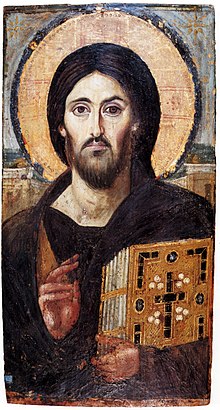
Back مسيح Arabic Хрыстос BE খ্রিষ্ট (উপাধি) Bengali/Bangla Crist Catalan مەسیح CKB Kristus Czech Crist CY Crist EML Kristo EO Cristo Spanish

| Part of a series on |
| Christianity |
|---|
 |
| Part of a series on |
| Christology |
|---|
Christ,[note 1] used by Christians as both a name and a title, unambiguously refers to Jesus.[5][6][7] It is also used as a title, in the reciprocal usage "Christ Jesus", meaning "the Messiah Jesus" or "Jesus the Anointed", and independently as "the Christ".[8] The Pauline epistles, the earliest texts of the New Testament,[9] often call Jesus "Christ Jesus" or just "Christ".[10]
The concept of the Christ in Christianity originated from the concept of the messiah in Judaism. Christians believe that Jesus is the messiah foretold in the Hebrew Bible and the Christian Old Testament. Although the conceptions of the messiah in each religion are similar, for the most part they are distinct from one another due to the split of early Christianity and Judaism in the 1st century.[citation needed]
Although the original followers of Jesus believed Jesus to be the Jewish messiah, e.g. in the Confession of Peter, he was usually called "Jesus of Nazareth" or "Jesus, son of Joseph".[11] Jesus came to be called "Jesus Christ" (meaning "Jesus the Khristós", i.e. "Jesus the Messiah" or "Jesus the Anointed") by Christians, who believe that his crucifixion and resurrection fulfill the messianic prophecies of the Old Testament, especially the prophecies outlined in Isaiah 53 and Psalm 22.[12]
- ^ Schönborn, Christoph (1994). God's human face: the Christ-icon. Ignatius Press. p. 154. ISBN 0-89870-514-2.
- ^ Galey, John (1986). Sinai and the Monastery of St. Catherine. American University in Cairo Press. p. 92. ISBN 977-424-118-5.
- ^ Zanzig, Thomas (2000). Jesus of history, Christ of faith. Saint Mary's Press. p. 314. ISBN 0-88489-530-0.
- ^ "Etymology Online: messiah". Etymonline.com. Retrieved November 19, 2010.
- ^ Prager, Edward (2005). A Dictionary of Jewish-Christian Relations. Cambridge University Press. p. 85. ISBN 0-521-82692-6.
- ^ Zanzig, Thomas (2000). Jesus of history, Christ of faith. Saint Mary's Press. p. 33. ISBN 0-88489-530-0.
- ^ Espin, Orlando (2007). n Introductory Dictionary of Theology and Religious Studies. Liturgical Press. p. 231. ISBN 978-0-8146-5856-7.
- ^ Cite error: The named reference
Pannenbergwas invoked but never defined (see the help page). - ^ Borg, Marcus (August 31, 2012). "A Chronological New Testament". The Huffington Post.
- ^ "Saint Paul, the Apostle". Encyclopædia Britannica. Retrieved May 23, 2013.
- ^ "Jesus Christ". Encyclopædia Britannica. Retrieved May 23, 2013.
- ^ "Isaiah 53 Bible Commentary - Matthew Henry (concise)". www.christianity.com. Retrieved November 11, 2023.
Cite error: There are <ref group=note> tags on this page, but the references will not show without a {{reflist|group=note}} template (see the help page).